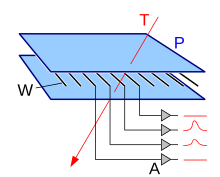Wire chamber
A wire chamber (also called multi-wire chamber ) is a detector for ionizing radiation , which is used, among other things, in accelerator experiments in elementary particle physics . In addition to displaying the presence of ionizing radiation (as with the Geiger-Müller counter tube ), the trajectories of the particles are also determined in the wire chamber.
The advantage of the wire chamber compared to the mist chamber and the bubble chamber lies in the electronic evaluation of the recorded data. There is no need to take a detour via photographic or video recordings, as is the case with the fog and bubble chamber and the spark chamber used previously . Far more events are recorded per time unit.
For the development of wire chamber at CERN was Nobel Prize for Physics in 1992 at Georges Charpak awarded.
functionality

The functional principle of the wire chamber is similar to that of the proportional counter tube . In a chamber filled with gas there are parallel wires that are at positive high voltage . A particle that flies through the chamber ionizes the gas along its path, creating an electrical current between the nearest wire and an adjacent cathode. While the conventional counter tube only has one wire and the cathode concentrically surrounds the wire as a tube, a wire chamber consists of many parallel wires between two cathode plates. The current pulses are picked up separately on each wire; this can be used to determine which wire the particle flew past. If you divide the cathode into narrow strips that run across the wires, and if you also measure the current on these strips, you can determine the point of intersection of a wire and a cathode strip near which the particle flew. Another way of determining the position of the particle in two dimensions is to mount two wire chambers with wires crossed one above the other. With several layers of such detectors, the particle trajectories can also be reconstructed three-dimensionally. Although the distances between the wires or cathode strips are in the range of several millimeters, the particle trajectories can be determined with an accuracy of a few tenths of a mm by comparing the impulses of neighboring wires or strips.
Wire chambers are operated as multi-wire proportional chambers (MWPC): The electrons are accelerated in the high electric field strength near the anode wires; when they hit gas atoms, they ionize them. This releases electrons again and (depending on the voltage and gas pressure applied) the current is amplified by a factor of 10 3 to 10 6 (charge avalanche). The current impulse is therefore proportional to the charge originally generated. This allows conclusions to be drawn about the type or energy of the particle. In contrast to the Geiger-Müller counter tube, the applied voltage is too low (and the gas pressure too high) to ignite an independent gas discharge . A mixture of the noble gas argon (main component) and another gas such as CO 2 or methane at a pressure of close to 1 bar is usually used as the gas . The addition of such a gaseous compound causes shorter impulses, thus making the detector “faster” by withdrawing some energy from the drifting free electrons through inelastic scattering on the molecules and thereby lowering their temperature. It also suppresses ultraviolet radiation , which could lead to excess pulses.
Drift chamber

The electrons need a certain amount of time to migrate (“drift”) from the location of the ionization in the particle path to the anode. If this time is determined in special wire chambers, the distance between the particle path and the wires can be measured and the particle path can thus be determined with high accuracy. Such an arrangement is called a drift chamber.
In order to measure the speed of the electrons in the gas ( drift speed ), there are special drift chambers, called Velocity Drift Chambers (VDC), in which gas molecules are ionized at known points and the drift time is then measured.
External magnetic field
In order to be able to precisely determine not only the path of the particles but also their momentum (and thus the energy if the type of particle is known), a homogeneous magnetic field is applied perpendicular to the direction of movement. The particles are deflected in the magnetic field by the Lorentz force . The momentum of the particle is determined from the curvature of the paths (see cyclotron radius ). Since the radius grows with the particle momentum, the curvature can be determined less and less precisely with increasing momentum (and thus higher particle energy). Therefore, this method for energy determination is generally not suitable for high-energy particles.
Individual evidence
- ^ EB Paul: Nuclear and Particle Physics , North-Holland, 1969, p. 124
- ↑ Knoll (see list of literature) p. 168
literature
- Glenn F. Knoll: Radiation Detection and Measurement. 2nd ed. New York etc .: Wiley, 1989
